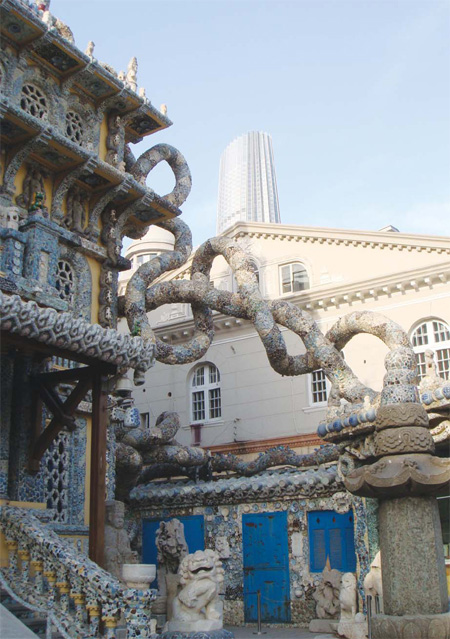Personal touch
Updated: 2010-12-17 13:09
By Zhang Jing (China Daily European Weekly)
 |
|
The China House, a private museum in Tianjin, against the |
Two-billion-yuan private museum creates waves in Tianjin and beyond
Visitors to Tianjin invariably head for the city's top attractions, including clay figurines, affordable seafood and the Goubuli or "Go Believe" stuffed buns. These days, however, tour guides may take you straight to the China House.
Built by Tianjin-born collector Zhang Lianzhi, the China House is a private museum that features more than 400 million porcelain fragments, 5,000 ancient vases and 4,000 dishes - all built into its fade.
Like giant psychedelic beanstalks in a Disney animation, countless tubes of cement thick as tree trunks and pasted with colorful porcelain fragments run up, down and through the four-story building.
The Huffington Post, a US news blog that attracts about 3 million viewers monthly according to AC Nielsen, has listed the China House as one of the world's 15 most stunning museums. Others on the list include New York City's Solomon R. Guggenheim Museum and Brazil's Niteri Contemporary Art Museum.
Still, many Tianjin residents have expressed their distaste for the city's China House through online forums and daily conversations. A number of tour guides also take their visitors to the front of the museum just for a few minutes so that they can snap a few shots of its exterior.
On the other hand, many of those who are willing to pay the 35-yuan (4 euros) ticket to go into the museum say they find it a real treat.
Hong Kun, a visitor from Shandong province who kept taking pictures of the museum from different angles inside and outside the building, says it is "amazing". Another visitor commented on the Baidu Chinese news blog that the China House curves reminded him of the works of Spanish architect Antoni Gaudi, who is famous for his unique and highly individualistic designs.
Zhang, 53, says the museum was his brainchild and took him eight years to complete. He renovated a French-style settlement in the 1920s to house his collection of antique china, chairs, wardrobes, a boat and a rusty cannon. Zhang says the museum is worth about 2 billion yuan (224 million euros) and has attracted more than 700,000 visitors from home and abroad since it opened in 2007.
Though it is called the China House, the museum does not follow rules of Chinese architectural tradition, with many of its items seemingly misplaced. The building is more like a self-expression of the owner's understanding of religion and art, primitive or chaotic. Giant stone lions, which usually sit in front of Chinese gates to ward off evil, are placed on the banisters of the museum's second-floor balcony. The faade's "beanstalks" are actually snakes embodying the union of the Chinese mythological ancestors Fuxi and Nuwa, who were similar to centaurs in Western mythology combinating human and animal forms, Zhang says.
Zhang himself does not have any formal training in art or design. Born in the late 1950s, his teenage years coincided with the "cultural revolution" (1966-1976), when most young people in China were deprived of a proper education. Zhang made money in the early 1980s and 1990s by selling cloth and running a seafood restaurant.
Zhang says his original inspiration for the house came from one incident in his teens. When his mother became upset after a chinaware inherited from ancestors was broken, Zhang pieced the shards to form a pyramid.
"You cannot imagine how happy she was when she saw it," Zhang says.
|
|
Zhang is also just one of a growing number of Chinese businessmen who have taken an interest in building private museums. There are more than 1,000 private museums and galleries like Zhang's said to have been built across China, with collections ranging from pianos and antique automobiles to teapots and keys.
In Shanghai, private museums sprouted in the mid-1980s and early 1990s, with up to 150 built. But many have since closed in the past few years. There used to be 15 private museums on Shanghai's Duolun Road but now there are only three left.
"It's easy to open a private museum or art gallery in China, but it's difficult to survive," says Mu Ye, curator of Beijing La Celeste Art Center.
Chen Zhiliang, professor of philosophy with Renmin University of China, attributes the short lifespan of most private museums to their lack of funds because they are under a system that categorizes private museums as companies rather than public projects.
Museum sponsors, if there are any, also cannot enjoy tax exemptions for the funds they give to private undertakings like the China House. But these sponsors can enjoy tax reductions of up to 12 percent of profits if the museums are considered public services.
"A sound social support system is needed if private museums in China are to develop in a healthy way," Chen says.
E-paper

Ear We Go
China and the world set to embrace the merciful, peaceful year of rabbit
Preview of the coming issue
Carrefour finds the going tough in China
Maid to Order
Specials

Mysteries written in blood
Historical records and Caucasian features of locals suggest link with Roman Empire.

Winning Charm
Coastal Yantai banks on little things that matter to grow

New rules to hit property market
The State Council launched a new round of measures to rein in property prices.

